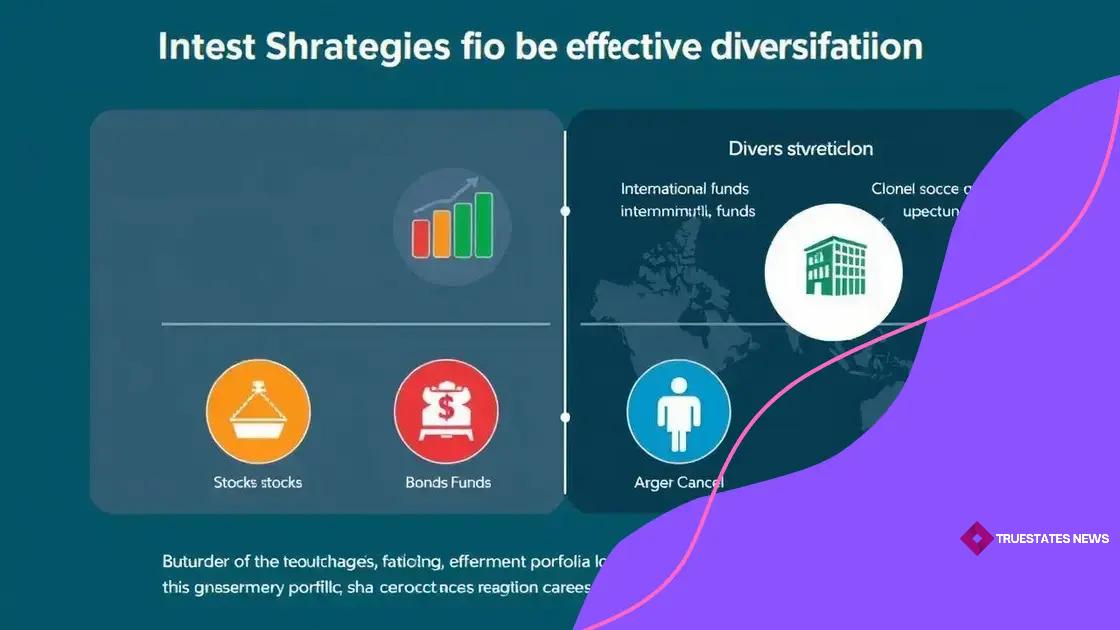Portfolio diversification: your pathway to financial security

Portfolio diversification is the practice of spreading investments across various asset classes to minimize risk and enhance potential returns, ensuring a balanced and resilient financial strategy.
Portfolio diversification is a crucial strategy for anyone looking to enhance their financial security. Have you ever wondered how spreading your investments can lead to greater safety and potential growth? In this piece, we’ll delve into why diversification matters and how you can achieve it effectively.
Understanding portfolio diversification
Understanding portfolio diversification is essential for anyone looking to enhance their investment strategy. By spreading investments across various asset classes, you can minimize risk and enhance potential returns. This approach allows your portfolio to weather market fluctuations more effectively.
What is Portfolio Diversification?
At its core, portfolio diversification means not putting all your eggs in one basket. It involves investing in different types of assets, such as stocks, bonds, and real estate. This way, if one investment performs poorly, others may perform better, balancing out the overall performance.
Key Benefits
- Risk Reduction: Diversifying means that the poor performance of a single asset will have a lesser impact on your overall portfolio.
- Improved Returns: A well-diversified portfolio is likely to have a better chance of achieving more stable, long-term returns.
- Market Protection: In volatile markets, diversification can help protect your investments from significant losses.
Another important aspect to consider is the correlation between various asset classes. Some investments may move in tandem, while others may not. By selecting assets that react differently in various market conditions, you can further enhance the resilience of your portfolio. For instance, while stocks may be volatile, bonds tend to be more stable, providing a cushion during tough times.
How to Diversify
Think about diversifying not just within a single asset class but also across multiple classes. Consider including domestic and international investments to take advantage of different economic factors. A diversified approach can involve mixing stocks from various sectors, investing in commodities, or adding real estate investments to the mix. Each of these has distinct characteristics and potential for growth.
It’s essential to establish your investment goals and risk tolerance before diversifying. This ensures that the assets you choose align with your financial objectives. Regularly reviewing and rebalancing your portfolio can help maintain your desired level of diversification over time.
Benefits of diversifying your investments
Understanding the benefits of diversifying your investments is crucial for achieving financial success. Diversification acts as a safety net, allowing you to minimize risks while maximizing potential returns. By spreading your investments across different asset classes, you can create a more stable financial future.
Risk Management
One of the primary advantages of diversification is risk management. When you invest in varied assets, the negative performance of one can be balanced by the positive performance of another. This balance can lead to a smoother overall return, reducing the chances of dramatic losses.
Potential for Higher Returns
A well-diversified portfolio can also enhance your chances for higher returns. While some investments may perform poorly, others may thrive in different market conditions. Investing in a mix of stocks, bonds, and alternative assets helps capture opportunities that arise across various sectors.
- Stability: Diversified portfolios often experience less significant swings in value.
- Growth Opportunities: Investing in multiple sectors can expose you to new growth areas.
- Inflation Protection: Different asset classes respond distinctly to inflation, protecting your purchasing power.
Diversification also aids in achieving your personal financial goals. Whether it’s saving for retirement, buying a home, or funding education, a diversified strategy can align your investments with these objectives. As you adjust your portfolio over time, consider incorporating various asset types to maintain a balance that meets your goals.
Another key aspect is the importance of periodic reviews. By regularly assessing your portfolio, you can ensure that your diversification strategy remains aligned with market changes and your evolving financial needs. Keeping an eye on asset allocation allows you to make informed adjustments when necessary.
Common strategies for effective diversification

Implementing common strategies for effective diversification is vital in building a robust investment portfolio. These strategies allow investors to minimize risks while maximizing potential returns. By following a few key practices, you can enhance your financial stability and growth prospects.
Asset Allocation
One of the most effective strategies is to practice asset allocation. This means dividing your investments across different asset classes such as stocks, bonds, real estate, and cash. A well-rounded allocation considers your risk tolerance and investment goals.
- Stocks: Offer potential for high returns but come with higher risks.
- Bonds: Provide stability and income, usually with lower risk than stocks.
- Real Estate: Can add a tangible asset to your portfolio, often appreciated over time.
Each asset class reacts differently to market conditions, which helps balance your overall investment risk. For instance, when stocks decline, bonds might perform better, thus providing a buffer.
Sector Diversification
Another important strategy is sector diversification. This approach involves investing in various industries rather than focusing solely on one. By spreading your investments across sectors such as technology, healthcare, and consumer goods, you reduce the impact of a downturn in any single industry.
It’s also essential to consider international diversification. Investing in global markets can provide exposure to economies that may perform differently from your home country. This adds another layer of protection against local economic downturns.
Regular Rebalancing
Implementing a strategy of regular rebalancing is crucial as market values change over time. Rebalancing involves adjusting your portfolio back to your original asset allocation. This ensures that you maintain your desired level of risk and capitalize on market fluctuations.
Setting specific time frames for rebalancing, such as every six months or annually, can help you stay on track. Additionally, consider rebalancing when significant market events occur. This proactive approach helps protect against unexpected market shifts.
Mistakes to avoid in portfolio diversification
Identifying mistakes to avoid in portfolio diversification is critical for maintaining a healthy investment strategy. Many investors unknowingly hinder their portfolio’s potential by making common errors. By recognizing these pitfalls, you can achieve a more balanced and effective investment approach.
Over-Diversification
One significant mistake is over-diversification. While spreading investments is essential, too much diversification can lead to a diluted portfolio, making it harder to achieve meaningful returns. If you spread your investments too thin, the performance of individual assets may not impact your overall portfolio.
It’s important to strike a balance, ensuring you have a variety of investments without overextending your options. Aim for a focused yet diverse portfolio that includes different asset classes without having an excessive number of investments in each category.
Ignoring Asset Allocation
Another common mistake is ignoring asset allocation. Failing to allocate your assets properly can result in misalignment with your investment goals and risk tolerance. For instance, if you’re young, you might favor stocks for growth potential. Conversely, those nearing retirement may prioritize bonds for stability.
- Know Your Risk Tolerance: Understand how much risk you are willing to take.
- Reviewing Regularly: Check your allocation to ensure it aligns with your goals.
- Investor Behavior: Avoid letting emotions guide your decisions during market fluctuations.
Regularly reviewing your portfolio and making necessary adjustments will help you stay on track with your investment objectives.
Chasing Past Performance
Another mistake to watch for is chasing past performance. Many investors fall into the trap of selecting investments solely based on their recent success. This approach can lead to poor investment choices, as past performance does not guarantee future results.
Instead of focusing on what has performed well, consider the current fundamentals and future potential of the assets. A sound investment strategy involves analyzing various factors such as market trends and economic conditions.
By staying informed and making choices based on thorough research rather than emotions or recent trends, you can better position your portfolio for long-term success.
How to assess your diversification needs
Knowing how to assess your diversification needs is key to a successful investment strategy. Assessing your needs allows you to determine the right balance of assets for your portfolio. This process involves understanding your financial goals, risk tolerance, and investment timeline.
Set Your Financial Goals
The first step is to clearly define your financial goals. Are you saving for retirement, a home, or your child’s education? Each goal has different timelines and risk levels. Understanding how much time you have until you need the funds can help shape your investment strategy.
Evaluate Your Risk Tolerance
Assessing your risk tolerance is another crucial element. Everyone has a unique comfort level when it comes to risk. Consider how you felt during past market fluctuations. Were you anxious, or did you stay calm? This self-assessment will give you a clearer idea of how much risk you can handle.
- High Risk Tolerance: You might choose a higher allocation to stocks for growth.
- Moderate Risk Tolerance: A balanced approach with stocks and bonds may suit you.
- Low Risk Tolerance: Focus on safer investments like bonds and cash equivalents.
Your risk tolerance will directly influence your diversification strategy. If you prefer less volatility, consider diversifying into lower-risk assets.
Examine Current Portfolio
Next, review your current portfolio. Look at existing investments to identify areas of concentration and identify if they align with your goals. Are you heavily invested in one sector or asset type? This could lead to unwanted risk. Instead, aim for a blend of assets across different sectors and geographical areas.
Analyze the performance of your investments to see if they match your expectations. If certain investments consistently underperform, it may be time to consider reallocating those funds. Lastly, consider your investment timeline. If you’re investing for the long term, you may afford more risk in your portfolio. On the other hand, if you need access to your money in the short term, a conservative approach would be better.
FAQ – Frequently Asked Questions About Portfolio Diversification
What is portfolio diversification?
Portfolio diversification involves spreading investments across various asset classes to reduce risk and enhance potential returns.
Why is understanding my risk tolerance important?
Understanding your risk tolerance helps you select appropriate investments, ensuring your portfolio aligns with your financial goals and comfort level.
How often should I review my diversified portfolio?
It’s recommended to review your portfolio at least annually or after significant market changes to ensure it still aligns with your objectives.
What common mistakes should I avoid in diversification?
Common mistakes include over-diversification, ignoring asset allocation, and chasing past performance, which can hinder your investment success.
